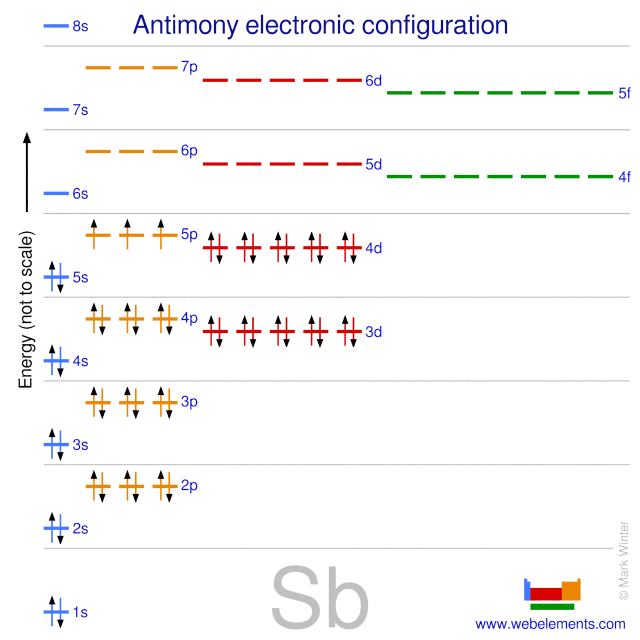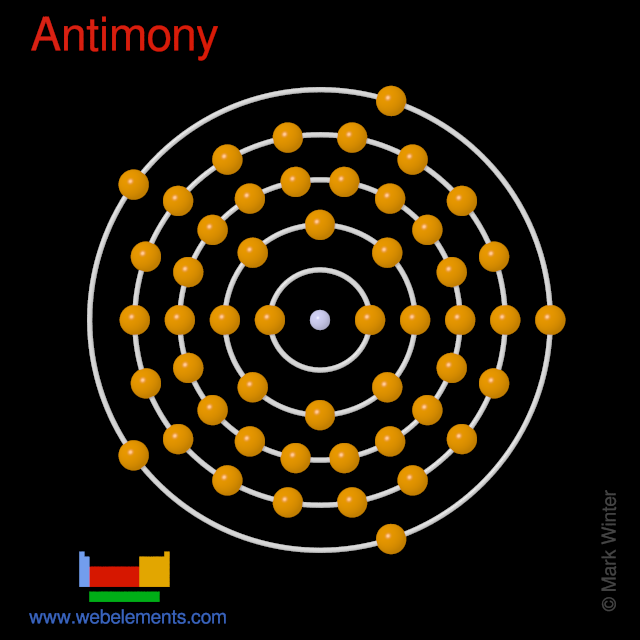Antimony - 51Sb: properties of free atoms
Antimony atoms have 51 electrons and the shell structure is 2.8.18.18.5.
The ground state electron configuration of ground state gaseous neutral antimony is [Kr].4d10.5s2.5p3 and the term symbol is 4S3/2.


Atomic spectrum
A representation of the atomic spectrum of antimony.
Ionisation Energies and electron affinity
The electron affinity of antimony is 103.2 kJ mol‑1. The ionisation energies of antimony are given below.

Effective Nuclear Charges
The following are "Clementi-Raimondi" effective nuclear charges, Zeff. Follow the hyperlinks for more details and for graphs in various formats.
| 1s | 49.97 | ||||||
|---|---|---|---|---|---|---|---|
| 2s | 37.60 | 2p | 46.87 | ||||
| 3s | 33.21 | 3p | 33.18 | 3d | 36.80 | ||
| 4s | 23.54 | 4p | 22.18 | 4d | 18.97 | 4f | (no data) |
| 5s | 11.61 | 5p | 9.99 | 5d | (no data) | ||
| 6s | (no data) | 6p | (no data) | ||||
| 7s | |||||||
References
These effective nuclear charges, Zeff, are adapted from the following references:
- E. Clementi and D.L.Raimondi, J. Chem. Phys. 1963, 38, 2686.
- E. Clementi, D.L.Raimondi, and W.P. Reinhardt, J. Chem. Phys. 1967, 47, 1300.
Electron binding energies
| Label | Orbital | eV [literature reference] |
|---|---|---|
| K | 1s | 30491 [1] |
| L I | 2s | 4698 [1] |
| L II | 2p1/2 | 4380 [1] |
| L III | 2p3/2 | 4132 [1] |
| M I | 3s | 940 [3] |
| M II | 3p1/2 | 812.7 [3] |
| M III | 3p3/2 | 766.4 [3] |
| M IV | 3d3/2 | 537.5 [3] |
| M V | 3d5/2 | 528.2 [3] |
| N I | 4s | 153.2 [3] |
| N II | 4p1/2 | 95.6 [3, one-particle approximation not valid owing to short core-hole lifetime] |
| N III | 4p3/2 | 95.6 [3, one-particle approximation not valid owing to short core-hole lifetime] |
| N IV | 4d3/2 | 33.3 [3] |
| N V | 4d5/2 | 32.1 [3] |
Notes
I am grateful to Gwyn Williams (Jefferson Laboratory, Virginia, USA) who provided the electron binding energy data. The data are adapted from references 1-3. They are tabulated elsewhere on the WWW (reference 4) and in paper form (reference 5).
References
- J. A. Bearden and A. F. Burr, "Reevaluation of X-Ray Atomic Energy Levels," Rev. Mod. Phys., 1967, 39, 125.
- M. Cardona and L. Ley, Eds., Photoemission in Solids I: General Principles (Springer-Verlag, Berlin) with additional corrections, 1978.
- Gwyn Williams WWW table of values
- D.R. Lide, (Ed.) in Chemical Rubber Company handbook of chemistry and physics, CRC Press, Boca Raton, Florida, USA, 81st edition, 2000.
- J. C. Fuggle and N. Mårtensson, "Core-Level Binding Energies in Metals," J. Electron Spectrosc. Relat. Phenom., 1980, 21, 275.
